This is a worksheet with exercises for self-learners and students.
1. Overview
Goals
This worksheet demonstrates how Apache Hop can be used to read, cleanse, filter, merge and store data.
The tasks consist of realistic examples that involve working with heterogeneous data. The aim is to show how to deal with this data when confronted with problems in this area.
After completing this worksheet, you will be able to:
-
Understand and operate Apache Hop.
-
Create simple data processing workflows in Apache Hop.
-
Merge multiple data sources using Apache Hop.
-
Transform column values and save them in a new column.
Time Required
The time required to complete this worksheet is about one hour for the reading part (without exercises), plus about five quarters of an hour for the exercises part—both depending on your previous knowledge and skills.
Prerequisites
In order to complete this worksheet, you need the following prerequisites:
-
Internet access to download the required software and data.
-
Java 17, available at oracle.com.
-
Software: Apache Hop, available for Windows, Mac and Linux, and to be installed as described below.
-
Data: File
Daten_OpenRefine.zipfrom OpenSchoolMaps
The following topics may be helpful as preparation for this topic:
-
Basic understanding of working with data.
-
The worksheet
Viewing, cleaning and integrating data with OpenRefineon OpenSchoolMaps.
Installation of Hop
Apache Hop can be downloaded from the Apache Hop website. It is important to note that Java 17 is required to start the application. Both the source code and the finished programme (binaries) are offered on the site. Only the binaries are required to run the application. The downloaded file contains everything you need to start Apache Hop on the most common operating systems.
| If you run into problems, there is GitHub Discussions, which contains information about a lot of the most common issues. |
Structure of this Worksheet
-
Introduction: Overview of Apache Hop, its functions and areas of application.
-
User interface (GUI): Description of the GUI and its elements for creating pipelines and workflows.
-
Apache Hop functions: Detailed explanations of various transformation options and data operations.
-
Exercises: Practical tasks on using Apache Hop, including data integration, cleansing and transformation.
-
Conclusion: Summary of concepts learnt and their practical relevance.
-
What was learnt: Overview of key lessons learnt from the exercises.
-
Appendix: Definitions: An overview over the most important keywords.
2. Apache Hop-Basics
Apache Hop (Hop Orchestration Platform) is an open source data orchestration platform, used for the creation of data integration processes. The application was developed in Java based on a platform-independent and modular architecture. This means that the application can be flexibly extended with plugins for a specific use case.
Hop uses a visual user interface to visualise the processes as clearly as possible. Local files as well as external databases can be used as a means of reading and saving data. Apache Hop findet Verwendung bei z.B.:
-
Data integration
-
Data migration
-
Automation of workflows and data processes
-
Data cleansing
The Hop Engine is the core of Apache Hop. It is accessible via three clients: Hop GUI, Hop Run and Hop Server. Hop GUI is the visual development environment in which data teams develop, test, execute and debug workflows and pipelines. Hop Run is the command line interface (CLI) for executing workflows and pipelines. Hop Server is a lean web server for executing workflows and pipelines as web services (HTTP REST API).
The User Interface (GUI)
Apache Hop offers a graphical user interface (GUI) in which the projects are created and displayed. It consists of a main window that serves as a workspace. The current project and its content are displayed here.
In Apache Hop, transforms, actions and hops are central concepts for processing and automating data.
-
Transforms are the individual processing steps within a pipeline. They perform tasks such as loading, converting or saving data.
-
Actions are the building blocks of a workflow and control processes, e.g. starting a pipeline, sending a notification or accessing external systems.
-
Hops connect transforms and display the data flow in a pipeline. In workflows, you define the sequence of actions.
These three elements enable a flexible and visual design of data processing and automation processes in Apache Hop.
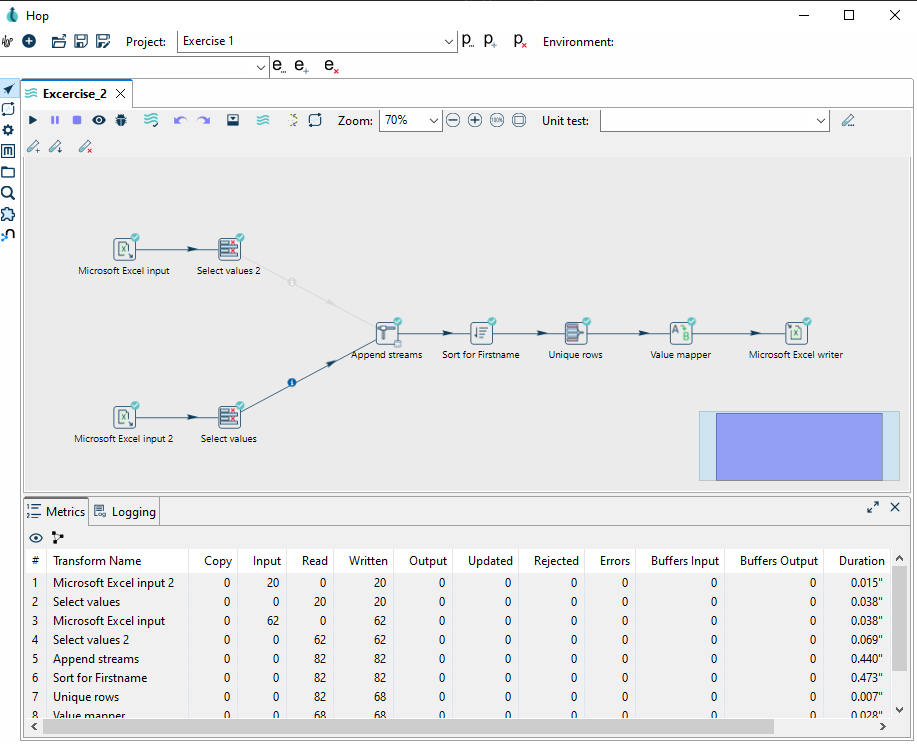
After a pipeline has been executed, a small icon appears next to the individual transforms, which you can click on to view the data at this point in the execution.
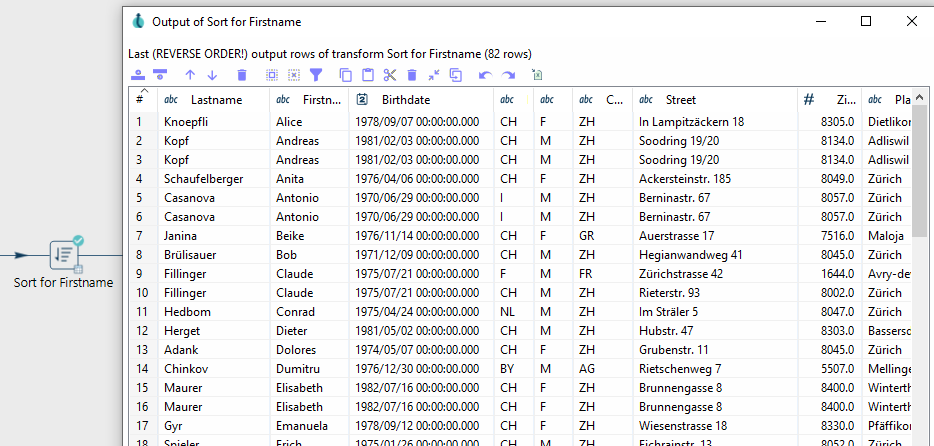
Pipelines can also be combined into larger constructs using workflows. Here, various pipelines, also called actions, are connected with hops. In this case, however, these represent the sequential execution of the individual actions.
Projects
In HOP, projects are the basis for all kinds of tasks.
| Environments in Apache Hop are predefined configurations that make it possible to run projects in different contexts without having to make manual adjustments. They contain specific settings such as variables, connection details or paths and can be used for development, test and production environments, for example. For example, a pipeline in the development environment can work with local files, while in the production environment it automatically uses a database as a source. Environments help to make workflows flexible and reusable. |
In addition, each project is assigned its own project folder in which the project files are saved. Apache Hop does not usually change the original data unless it is configured to do so in the pipeline.
3. Apache Hop-Functions
Apache Hop offers a wide range of powerful functions for efficient control of the entire data flow. Data can be easily imported and exported as well as transformed, merged and validated in complex workflows. The modular and visual interface enables flexible integration and customization of processes, which offers decisive advantages, particularly when importing data, combining data streams and cleansing data records. Some of these functions are explained in more detail below.
In- and Output
In Apache Hop there is a large selection of input and output transforms that can be used to read and write data. A few selected transforms are described below.
Excel Input
Excel files can be integrated directly into a pipeline as a data source with the Microsoft Excel Input.
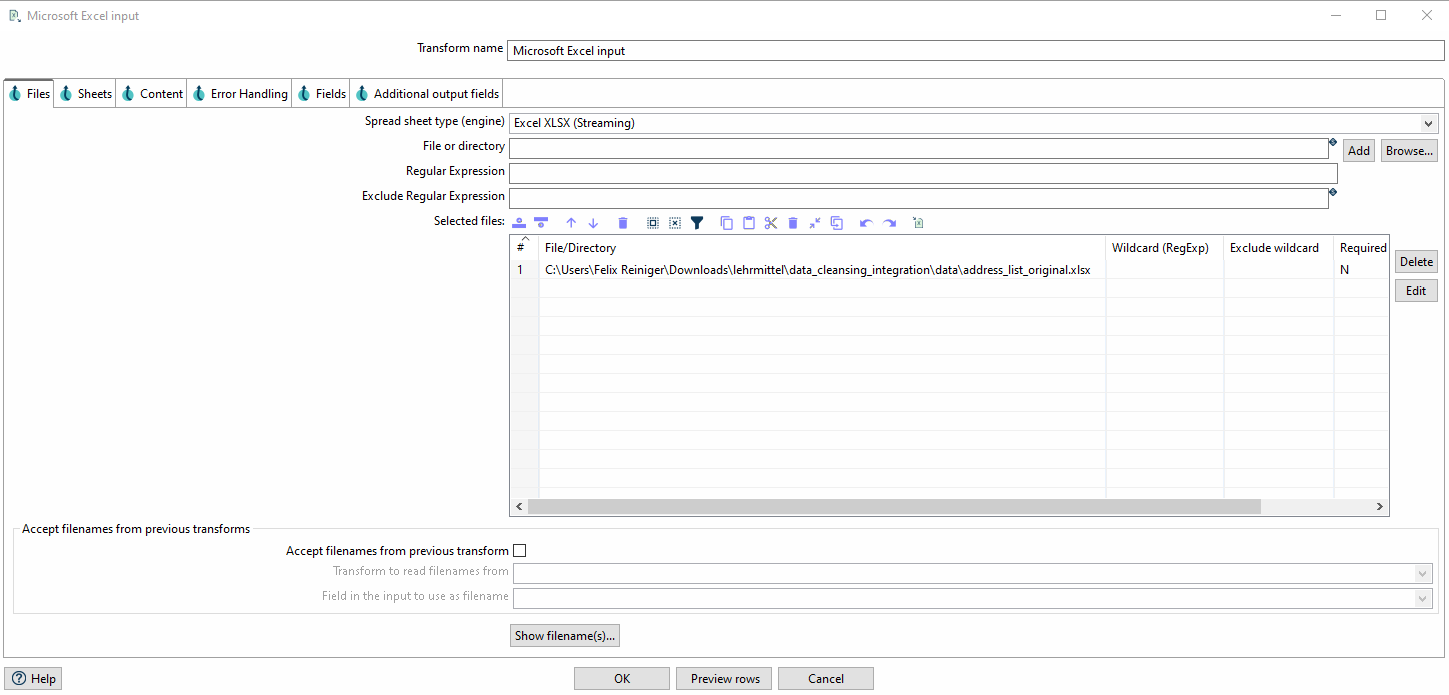
In the tab, the file must first be referenced and then added to the list of Selected Files by clicking on Add.
The corresponding sheets to be read can then be selected in the tab under Get sheetnames(s)….
Finally, the header can be read in in the tab via Get fields from header row…. If desired, the data types of the individual columns can now be customised.
Excel Writer
The Microsoft Excel Writer can be used to save a data flow as an Excel file (.xlsx, .xls).
To Export the data as a Excel file you’ll have to reference a saving location.
Transforms
Apache Hop is particularly powerful when it comes to transforming data. Thanks to the visual representation, pipelines can be efficiently compiled and analysed. As Hop has a flexible structure, it can also be easily integrated into existing processes and infrastructures. Some of the available transformations are listed and explained below.
Merging data records from different sources
Apache Hop offers various functions for merging different data. Depending on what is to be achieved, different transforms can be used.
Append Streams Transform
The Append Streams transform can be used to append one data flow to another.
The parameters refer to Tail and Head. The tail is placed at the end of the head.
The schema, i.e. the columns of the tables and their data types, of the two sources must be identical,
otherwise an error will occur.
Merge Join Transform
The Merge Join transform in Apache Hop enables two data streams to be linked using a common key.
A join type such as INNER, LEFT OUTER or FULL OUTER is selected, similar to SQL joins.
It is important that the input data is sorted in advance, as Merge Join does not perform automatic sorting.
After the join, the combined data records are processed as a single data stream.
Validating and Deduplication
Sorting Transform
The Sorting Transform sorts a data flow alphabetically/numerically in ascending or descending order.
The corresponding columns must be selected in the parameters. Several columns can also be selected.
In this case, the order in which the columns are specified is decisive.
Unique Rows Transform
Duplicates can be removed with the Unqiue Rows Transform.
Columns relevant for checking can be defined in the parameters.
However, this transform only works with sorted data flows.
Accordingly, a Sorting transform must be applied beforehand.
Value Mapper Transform
The Value Mapper Transform is used to convert values within a data stream. It makes it possible to replace certain input values with defined target values.
To use it, add a Value Mapper transform in a pipeline.
Open the parameters and enter the original value under Source value and the desired target value under Target value.
After saving, the defined values are automatically replaced when running through the pipeline.
This is particularly useful for data cleansing or the standardisation of values.
Exercise 1: First Apache hop pipeline
In this exercise, you will build a simple pipeline with Apache Hop. An Excel file is read in, filtered, the data is cleansed and finally saved again.
Data
For this excersise address_list_original.xlsx is used.
This is part of the zip archive Daten_OpenRefine.zip, which you can download from OpenSchoolMaps
(same section as this worksheet).
Step 1: Create a Project
To create a project - the actual workspace in which you work with the data - you must do the following:
-
start Apache Hop on your local machine.
-
click on Add a new Project in the top bar.
-
in the new window you must give the project a name and define a
Home folder. You can confirm the entry with OK. -
a new window then appears in which you can define enviorment variables. You can click these away with No.
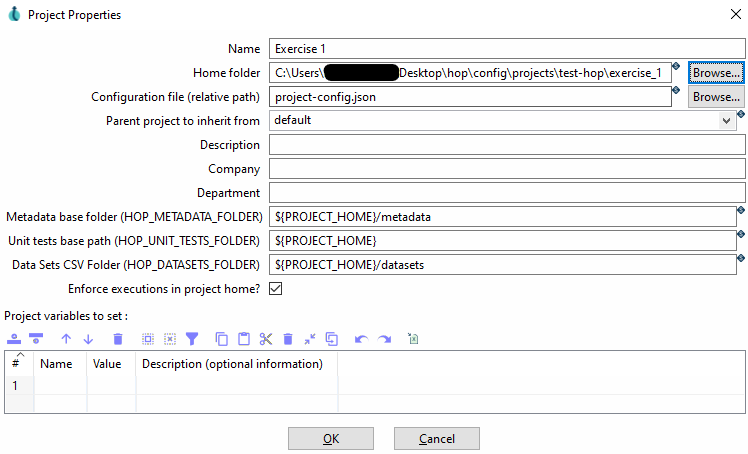
Step 2: Load and Validate Data
Filter out all Customers that are not from Zurich, so the dataset only includes customers from Zurich.
-
load the data from the file
address_list_original.xlsxwith the help ofMicrosoft Excel Input. -
apply the transform
Filter rowsto the columnCantonto filter only customers who live in the cantonZH. -
use the separate transform
Standardize phone numberto add the country code and bring the phone number into a standardised format.
Standardise Phone Number is a transform that is exemplary for transforms added by plugins.
Alternatively, you can also use a String Operation to convert the data into the desired form.
|
Step 3: Export Data
Once you have completed the above tasks, you can add an export to the pipeline.
Use the Microsoft Excel Writer for this.
In the options, select xlsx [Excel 2007 and above] as the format and choose a suitable file name.
Exercise 2: Integrating another data set
In this exercise, you integrate a data record into a predefined target data record. Some column names and structures are changed, otherwise the data set remains unchanged. Such scenarios are common in practice, as data from various sources have to be merged into a comprehensive data set. With Apache Hop, you can use various techniques - such as mapping attributes, merging and splitting fields, and deduplication. and deduplication - to successfully standardise the different data streams.
Data
The data from the files address_list_original.xlsx & address_list_scrambled.xlsx are used for this task.
Step 1: Create a Project
Once you have downloaded both Excel files, create a new pipeline by clicking on the + in the top bar and selecting Pipeline.
Step 2: Integrate the Data
To import both data into one pipeline, two separate Microsoft Excel inputs must be created. Reference one Excel file for each transform. You will then first convert the data into a standardised format, before you merge the two data flows.

Step 2.1 Merging and standardising the columns from both files
First of all, you need to look at the columns in both files and find out which columns belong together.
Once you have found matching columns, they must first be matched using Select Values and then merged using Append Streams.
Append Streams only works with data that has an identical structure.
As soon as the tables have been merged, they can be processed further.
In the parameters for Select Values you can rename the column under rename.
You can also use Remove to remove columns such as CustID that only occur in one table.

If both streams generate an identical schema, they can be merged with Append Streams.
You must define head and tail in the parameters. However, the order does not play a role in this example.
| If you now execute the pipeline and an error occurs, it may well be that the two streams do not yet have an identical schema. |
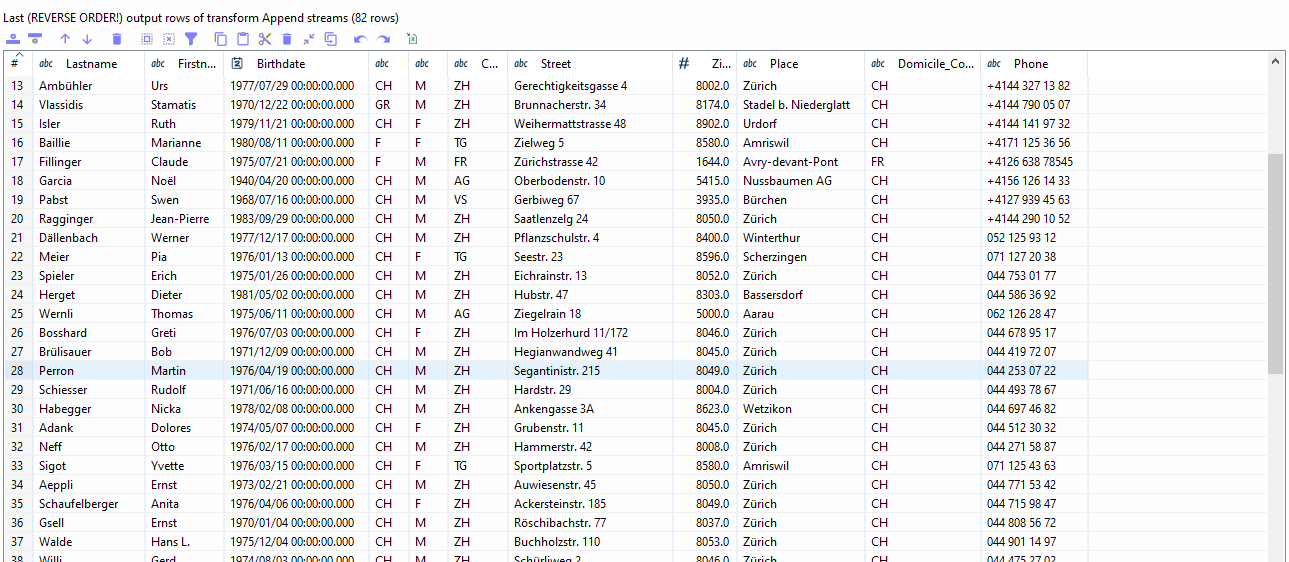
Step 2.2 Deduplication of the data
The next step is to deduplicate the data. Some data from the second file is also present in the first file, which means that these are duplicates, which you need to remove and only keep one of the entries. There is also other data in the second file that does not exist in the first file (i.e. no duplicates), so you do not need to remove them.
In order for a stream to be cleaned up using Unique Rows, it must first be sorted.
You can use the Sort transform for sorting.
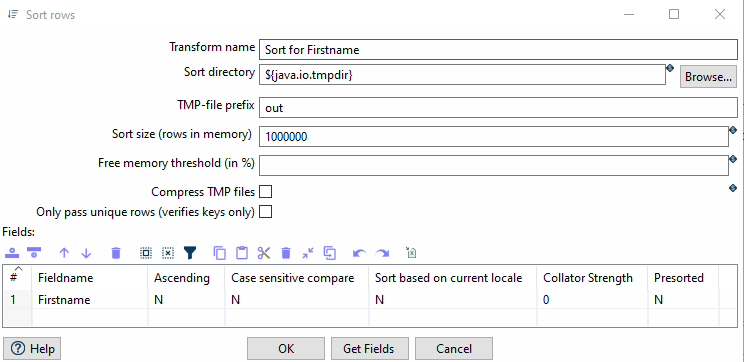
| It is important that all rows are sorted according to the columns that are used to identify the duplicate rows, are sorted. However, it does not matter whether this is in ascending or descending order. |
For a data record to be considered a duplicate, the following condition must be met: If the first name, surname and date of birth are identical, it is the same person, i.e. a duplicate.
For this we can use the Unique Rows Transform, which removes duplicates.
If no specific columns are specified in the parameters, all columns are checked.
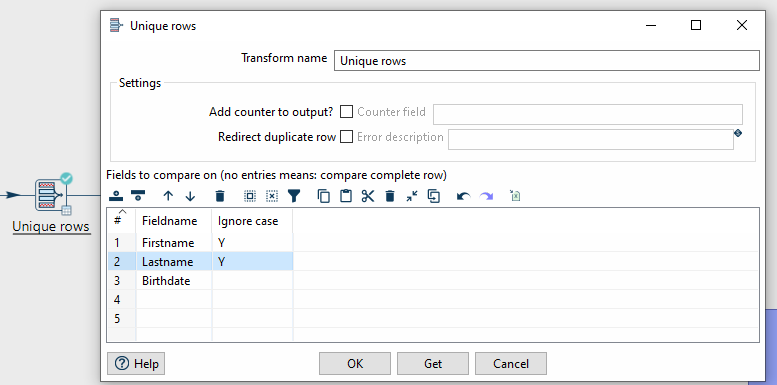
Unique Rows Transform.Step 3: Finalisation
The telephone numbers are stored in different formats in the ‘Phone’ column. Apply what you have learnt from task 1. However, make sure that international telephone numbers also have the correct dialling code.
| Use other columns for help if necessary. |
Once this last task has been completed, the source data is successfully integrated, validated and deduplicated in the target data set.
Step 4: Exporting the data
Add an Export tranform to your pipeline to export the files in MS Excel 2007+ (.xslx) format and finish this exercise.
complete this exercise.
Exercise 3: Using Value Mapper Transform
The aim of this exercise is to add another column based on the existing data.
In this case, the Sex/Gender column is to be used to create a new column called Salutation, which contains the corresponding salutation.
Data
For this task, you can either use the pipeline from task 2 or use address_list_original.xlsx.
Step 1: Create project and import data (optional)
If you are working with a new pipeline, you must first create a new pipeline via the + and read the data from the Excel file using an Excel Reader,
Step 2: Create Value Mapper Transform
Use a Value-Mapper transform to create a new column called Salutation, which inserts M → Male or F → Female depending on the gender specified.
is specified, which inserts M → Mr or F → Female.
Step 3: Export data
To complete this task, the data must be exported to the format MS Excel 2007+ (.xslx) using an Excel Writer transform.
format.
4. Conclusion
Based on the points discussed, it was shown that Apache Hop is a powerful tool for processing and preparing data. data. The intuitive and visual environment makes it easy to visualise and understand complex processes.
Working with data and transforming it into something meaningful and useful requires a lot of logical, technical and practical knowledge. practical knowledge is required. In the exercises, you will hopefully have learnt how to deal with confusing data and which functions and tools to choose for different data problems. tools you can choose for different data problems.
5. Things learned
-
Create a project in Apache Hop.
-
Transforming a dataset with Apache Hop, using different transforms.
-
Using Apache Hop to clean/duplicate and integrate one dataset into another.
-
Use a
Value Mappertransform to create a new column.
6. Appendix: Definitions
Tools
Apache Hop offers several tools for modelling, executing and managing data integration processes. The most important are:
-
Hop Gui: Main user interface for graphically creating pipelines and workflows. When starting out, the only tool required.
-
Hop Run: Command line tool for executing workflows and pipelines.
-
Hop Conf: Configuration tool for managing projects and environments.
-
Hop Server: Lightweight web server for remote execution of pipelines and workflows.
-
as well as other tools, such as Hop Encrypt (passwords), Hop Search (metadata objects in projects), Hop Import (for Kettle)
Workflow
A structured sequence of one or more pipelines and actions. Is used to control the data flow, i.e. for flow and error logic, time control and conditional executions. Used for data flow management. (Not used in this exercise).
Pipeline
Structured sequence for data processing, consisting of individual transforms, connected by hops. Used for the actual data processing: Loading, transforming and writing data. Can be parallelised and runs data set-oriented.
Transform
A processing step within a pipeline (e.g. reading, filtering, converting data). Performs operations such as filtering, renaming, joining or converting. Works on tabular data and changes schema or format if necessary. Part of data processing.
Hop (within pipelines)
Connects Transforms in pipelines, Actions in workflows and controls the flow of data from one step to the next.
Action
An operation within a workflow - e.g. to start a pipeline or send an email. Performs tasks such as starting a pipeline, sending an email or waiting for a file. Returns boolean result values (success/failure). Does no own data processing. (Not used in this exercise).
Project
A logical collection of pipelines, workflows, metadata and configurations. Used to structure hop content. Supports project-specific configurations such as parameters (declarative variables, can also have default values) or simple variables (key-value pairs that are used at runtime).
Environment
A collection of configuration values that are applied to a project at runtime. Allows pipelines and workflows to be executed in different contexts (e.g. Dev, Test, Prod).
Metadata
Reusable objects such as database connections, file formats, table descriptions or user-defined values. Are managed centrally and referenced in pipelines/workflows.
File Definition
A metadata structure that describes how a structured file (e.g. CSV) should be read or written (e.g. separator, header, character set).
Execution Engine
Apache Hop supports multiple execution engines, e.g. the local engine or Apache Beam for scalable and distributed execution.
Hop Web
(future) planned web interface for control and modelling. Currently not included in the stable version, but under development.
Metadata injection
Dynamic insertion of metadata into pipelines to create flexible, parameterisable processes - e.g. based on Excel or database definitions.
Row
Basic unit of data processing in a pipeline. A row can consist of any number of fields (e.g. attributes such as customer_id, amount, timestamp).
Any more questions? Please contact Stefan Keller (stefan.keller@ost.ch)!
![]() Freely usable under CC0 1.0: http://creativecommons.org/publicdomain/zero/1.0/
Freely usable under CC0 1.0: http://creativecommons.org/publicdomain/zero/1.0/